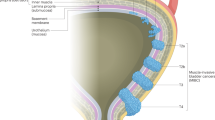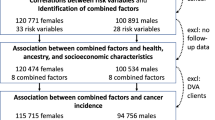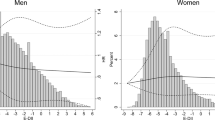Abstract
Mortality from bladder cancer has shown downward trends over the last 2 decades in several western European countries (albeit 10–15 years later than similar trends in the US), but is still increasing in some eastern European countries. Tobacco smoking and occupational exposure to aromatic amines are the two major established environmental risk factors for bladder cancer. Controlling exposure to these factors has been an important contributor to the reduction in bladder cancer mortality, particularly among men. Diet could influence bladder carcinogenesis, as many compounds contained in foods—and their metabolites—are excreted through the urinary tract. Fruit and vegetable consumption was inversely related with bladder cancer in many studies, but no consistent association has emerged between intake of related micronutrients and reduced risk of bladder cancer. Other widely investigated lifestyle habits are probably not associated with risk of developing bladder cancer (e.g. coffee consumption, artificial sweetener use, hair dyes) or are difficult to assess (e.g. fluid intake). Infections and stones in the urinary tract might cause chronic irritation of the bladder epithelium, and thus increase bladder cancer risk. First-degree relatives of bladder cancer patients have a 50–100% increased relative risk of developing the disease, a risk that could be even higher when the proband is diagnosed at an early age.
Key Points
-
Trends in male mortality rates in Europe and other developed areas of the world are declining, reflecting reduced exposure to tobacco smoking and occupational carcinogens mainly in male populations
-
Cigarette smoking, occupational exposure to aromatic amines, and infection with Schistosoma haematobium are the main recognized risk factors for developing bladder cancer
-
Other potential etiologic factors for bladder cancer include occupational exposure to polycyclic aromatic hydrocarbons, low consumption of vegetables and fruit, urinary tract infections (other than Schistosoma haematobium), and drinking tap water with chlorine or chlorination byproducts or water contaminated with arsenic
-
Slow N-acetyltransferase-2 acetylation status is associated with a modest increase in bladder cancer risk
-
A positive family history of bladder cancer in first-degree relatives approximately doubles the risk of the same cancer: potential interactions between genetic and environmental factors in bladder cancer risk have been reported, but are still not consistently assessed
This is a preview of subscription content, access via your institution
Access options
Subscribe to this journal
Receive 12 print issues and online access
$209.00 per year
only $17.42 per issue
Buy this article
- Purchase on Springer Link
- Instant access to full article PDF
Prices may be subject to local taxes which are calculated during checkout

Similar content being viewed by others
References
Parkin DM et al. (1999) Estimates of the worldwide incidence of 25 major cancers in 1990. Int J Cancer 80: 827–841
Silverman DT et al. (1996) Bladder cancer. In Cancer Epidemiology and Prevention, edn 2, 1156–1179 (Eds Schottenfeld D, Fraumeni JF Jr); New York: Oxford University Press
La Vecchia C and Airoldi L (1999) Human bladder cancer: epidemiological, pathological and mechanistic aspects. In Proceedings of a consensus conference. Species differences in thyroid, kidney and urinary bladder carcinogenesis: 1997 November 3–7; Lyon, France, 139–157 (Eds Capen CC et al.); IARC Scientific Publication No. 147. Lyon: International Agency for Research on Cancer
Negri E and La Vecchia C (2001) Epidemiology and prevention of bladder cancer. Eur J Cancer Prev 10: 7–14
Bedwani et al. (1993) Descriptive epidemiology of bladder cancer in Egypt. Int J Cancer 55: 351–352
Hankey BF et al. (1991) Problems in cancer surveillance: delineating in situ and invasive bladder cancer. J Natl Cancer Inst 83: 384–385
Lynch CF et al. (1991) Cancer registry problems in classifying invasive bladder cancer. J Natl Cancer Inst 83: 429–433
Levi F et al. (1998) Cancer incidence and mortality in Europe. J Epidemiol Biostat 3: 295–373
Levi F et al. (2004) Cancer mortality in Europe, 1995–1999, and an overview of trends since 1960. Int J Cancer 110: 155–169
Bosetti C et al. (2005) Trends in cancer mortality in the Americas, 1970–2000. Ann Oncol 16: 489–511
Wynder EL et al. (1988) Effect of the type of cigarette smoked on bladder cancer risk. Cancer 61: 622–627
World Health Organization, International Agency for Research on Cancer (2004) Tobacco smoke and involuntary smoking, vol 83 IARC Monographs on the Evaluation of the Carcinogenic Risks to Humans. Lyon: International Agency for Research on Cancer
Zeegers MP et al. (2004) The association between smoking, beverage consumption, diet and bladder cancer: a systematic literature review. World J Urol 21: 392–401
Castelao JE et al. (2001) Gender- and smoking- related bladder cancer risk. J Natl Cancer Inst 93: 538–545
World Health Organization, International Agency for Research on Cancer (1987) Overall evaluations of carcinogenicity: an updating of IARC monographs vols 1 to 42, Supplement 7, IARC Monographs on the Evaluation of the Carcinogenic Risks to Humans. Lyon: International Agency for Research on Cancer
World Health Organization, International Agency for Research on Cancer (1982) The rubber industry, vol 28 IARC Monograph on the Evaluation of Carcinogenic Risks to Humans. Lyon: International Agency for Research on Cancer
Bosetti C et al. (2005) Bladder cancer risk in painters: a review of the epidemiological evidence, 1989–2004. Cancer Causes Control 16: 997–1008
Bosetti C et al. Occupational exposures to polycyclic aromatic hydrocarbons, and respiratory and urinary tract cancers: a quantitative review to 2005. Ann Oncol, in press.
Kogevinas M et al. (2003) Occupation and bladder cancer among men in Western Europe. Cancer Causes Control 14: 907–914
Gago-Dominguez M et al. (2001) Use of permanent hair dyes and bladder-cancer risk. Int J Cancer 91: 575–579
Henley SJ and Thun MJ (2001) Use of permanent hair dyes and bladder-cancer risk. Int J Cancer 94: 903–906
Hartge P et al. (1982) Use of hair dyes and risk of bladder cancer. Cancer Res 42: 4784–4787
Czene K et al. (2003) Cancer risks in hairdressers: assessment of carcinogenicity of hair dyes and gels. Int J Cancer 105: 108–112
Takkouche B et al. (2005) Personal use of hair dyes and risk of cancer: a meta-analysis. JAMA 293: 2516–2525
La Vecchia C and Tavani A (2001) Hair dyes and bladder cancer: an update. Eur J Cancer Prev 10: 205–208
Michaud DS et al. (1999) Fluid intake and the risk of bladder cancer in men. N Engl J Med 340: 1390–1397
Altieri A et al. (2003) Fluid intake and risk of bladder and other cancers. Eur J Clin Nutr 57 (Suppl 2): S59–S68
Cantor KP et al. (1998) Drinking water source and chlorination byproducts. I. Risk of bladder cancer. Epidemiology 9: 21–28
Villanueva CM et al. (2003) Meta-analysis of studies on individual consumption of chlorinated drinking water and bladder cancer. J Epidemiol Community Health 57: 166–173
Chen CJ et al. (1986) A retrospective study on malignant neoplasms of bladder, lung and liver in blackfoot disease endemic area in Taiwan. Br J Cancer 53: 399–405
National Research Council, Board on Environmental Studies and Toxicology. Subcommittee (2001) Arsenic in drinking water: 2001 update. Washington, DC: The National Academies Press
Chen Y and Ahsan H (2004) Cancer burden from arsenic in drinking water in Bangladesh. Am J Public Health 94: 741–744
Michaud DS et al. (2004) Arsenic concentrations in prediagnostic toenails and the risk of bladder cancer in a cohort study of male smokers. Am J Epidemiol 160: 853–859
Zeegers MP et al. (2001) Are coffee and tea consumption associated with urinary tract cancer risk? A systematic review and meta-analysis. Int J Epidemiol 30: 353–362
Zeegers MP et al. (2001) Are coffee, tea, and total fluid consumption associated with bladder cancer risk? Results from the Netherlands Cohort Study. Cancer Causes Control 12: 231–238
Geoffroy-Perez B and Cordier S (2001) Fluid consumption and the risk of bladder cancer: results of a multicenter case–control study. Int J Cancer 93: 880–887
Steinmaus CM et al. (2000) Diet and bladder cancer: a meta-analysis of six dietary variables. Am J Epidemiol 151: 693–702
Nagano J et al. (2000) Bladder-cancer incidence in relation to vegetable and fruit consumption: a prospective study of atomic-bomb survivors. Int J Cancer 86: 132–138
Michaud DS et al. (2002) Intakes of fruits and vegetables, carotenoids and vitamins A, E, C in relation to the risk of bladder cancer in the ATBC cohort study. Br J Cancer 87: 960–965
Sun CL et al. (2004) Dietary soy and increased risk of bladder cancer: a prospective cohort study of men in Shanghai, China. Int J Cancer 112: 319–323
Zeegers MP et al. (2001) Are retinol, vitamin C, vitamin E, folate and carotenoids intake associated with bladder cancer risk? Results from the Netherlands Cohort Study. Br J Cancer 85: 977–983
Castelao JE et al. (2004) Carotenoids/vitamin C and smoking-related bladder cancer. Int J Cancer 110: 417–423
Jacobs EJ et al. (2002) Vitamin C and vitamin E supplement use and bladder cancer mortality in a large cohort of US men and women. Am J Epidemiol 156: 1002–1010
Zeegers MP et al. (2002) Prediagnostic toenail selenium and risk of bladder cancer. Cancer Epidemiol Biomarkers Prev 11: 1292–1297
World Health Organization, International Agency for Research on Cancer (1999) Some chemicals that cause tumours of the kidney or urinary bladder in rodents and some other substances, vol 73 IARC Monograph on the Evaluation of Carcinogenic Risks to Humans. Lyon: International Agency for Research on Cancer
Howe GR et al. (1977) Artificial sweeteners and human bladder cancer. Lancet 2: 578–581
Hoover RN and Strasser PH (1980) Artificial sweeteners and human bladder cancer. Preliminary results. Lancet 1: 837–840
Pereg D and Lishner M (2005) Non-steroidal anti-inflammatory drugs for the prevention and treatment of cancer. J Intern Med 258: 115–123
Castelao JE et al. (2000) Non-steroidal anti-inflammatory drugs and bladder cancer prevention. Br J Cancer 82: 1364–1369
Castelao JE et al. (2003) Phenobarbital use and bladder cancer risk. Eur J Epidemiol 18: 659–664
Habel LA et al. (1998) Barbiturates, smoking and bladder cancer risk. Cancer Epidemiol Biomarkers Prev 7: 1049–1050
International Agency for Research on Cancer (1994) Schistosomes, liver flukes and Helicobacter pylori. IARC Monographs on the Evaluation of the Carcinogenic Risks to Humans, vol 61. International Agency for Research on Cancer, Lyon.
Bedwani R et al. (1998) Schistosomiasis and the risk of bladder cancer in Alexandria, Egypt. Br J Cancer 77: 1186–1189
Kantor AF et al. (1984) Urinary tract infection and risk of bladder cancer. Am J Epidemiol 119: 510–515
Wynder EL et al. (1963) An epidemiological investigation of cancer of the bladder. Cancer 16: 1388–1407
La Vecchia C et al. (1991) Genital and urinary tract diseases and bladder cancer. Cancer Res 51: 629–631
Christensen M et al. (2000) Microsatellite alterations in urinary sediments from patients with cystitis and bladder cancer. Int J Cancer 85: 614–617
Chow W-H et al. (1997) Risk of urinary tract cancers following kidney or ureter stones. J Natl Cancer Inst 89: 1453–1457
Goldgar DE et al. (1994) Systematic population-based assessment of cancer risk in first-degree relatives of cancer probands. J Natl Cancer Inst 86: 1600–1608
Plna C and Hemminki K (2001) Familial bladder cancer in the national Swedish Family Cancer Database. J Urol 166: 2129–2133
Aben KK et al. (2002) Familial aggregation of urothelial cell carcinoma. Int J Cancer 98: 274–278
Kramer AA et al. (1991) Familial aggregation of bladder cancer stratified by smoking status. Epidemiology 2: 145–148
Vogelstein B and Kinzler KW (2004) Cancer genes and the pathways they control. Nat Med 10: 789–799
Rothman N et al. (1996) The impact of interindividual variation in NAT2 activity on benzidine urinary metabolites and urothelial DNA adducts in exposed workers. Proc Natl Acad Sci USA 93: 5084–5089
Blum M et al. (1991) Molecular mechanism of slow acetylation of drugs and carcinogens in humans. Proc Natl Acad Sci USA 88: 5237–5241
Okkels H et al. (1997) Arylamine N-acetyltransferase 1 (NAT1) and 2 (NAT2) polymorphisms in susceptibility to bladder cancer: the influence of smoking. Cancer Epidemiol Biomarkers Prev 6: 225–231
Wacholder S et al. (2004) Assessing the probability that a positive report is false: an approach for molecular epidemiology studies. J Natl Cancer Inst 96: 434–442
Marcus PM et al. (2000) NAT2 slow acetylation and bladder cancer risk: a meta-analysis of 22 case–control studies conducted in the general population. Pharmacogenetics 10: 115–122
Marcus PM et al. (2000) Cigarette smoking, N-acetyltransferase 2 acetylation status, and bladder cancer risk: a case-series meta-analysis of a gene-environment interaction. Cancer Epidemiol Biomarkers Prev 9: 461–467
Bell DA et al. (1995) Polymorphism in the N-acetyltransferase 1 (NAT1) polyadenylation signal: association of NAT1*10 allele with higher N-acetylation activity in bladder and colon tissue. Cancer Res 55: 5226–5229
Badawi AF et al. (1995) Role of aromatic amine acetyltransferases, NAT1 and NAT2, in carcinogen-DNA adduct formation in the human urinary bladder. Cancer Res 55: 5230–5237
Bryant MS et al. (1988) Hemoglobin adducts of aromatic amines: associations with smoking status and type of tobacco. Proc Natl Acad Sci USA 85: 9788–9791
Talaska G et al. (1991) Detection of carcinogen-DNA adducts in exfoliated urothelial cells of cigarette smokers: association with smoking, hemoglobin adducts, and urinary mutagenicity. Cancer Epidemiol Biomarkers Prev 1: 61–66
Yu MC et al. (1994) Acetylator phenotype, aminobiphenyl-hemoglobin adduct levels, and bladder cancer risk in white, black, and Asian men in Los Angeles, California. J Natl Cancer Inst 86: 712–716
Brockmöller J et al. (1994) Glutathione S-transferase M1 and its variants A and B as host factors of bladder cancer susceptibility: a case–control study. Cancer Res 54: 4103–4111
Yu MC et al. (1995) Glutathione S-transferase M1 genotype affects aminobiphenyl-hemoglobin adduct levels in white, black and Asian smokers and nonsmokers. Cancer Epidemiol Biomarkers Prev 4: 861–864
Garcia-Closas M et al. (2005) NAT2 slow acetylation, GSTM1 null genotype, and risk of bladder cancer: results from the Spanish Bladder Cancer Study and meta-analyses. Lancet 366: 649–659
Gago-Dominguez M et al. (2003) Permanent hair dyes and bladder cancer: risk modification by cytochrome P4501A2 and N-acetyltransferases 1 and 2. Carcinogenesis 24: 483–489
Howe GR et al. (1980) Tobacco use, occupation, coffee, various nutrients, and bladder cancer. J Natl Cancer Inst 64: 701–713
Ohno Y et al. (1985) Case–control study of urinary bladder cancer in metropolitan Nagoya. Natl Cancer Inst Monogr 69: 229–234
Claude J et al. (1986) Life-style and occupational risk factors in cancer of the lower urinary tract. Am J Epidemiol 124: 578–589
Nomura A et al. (1989) Smoking, alcohol, occupation, and hair dye use in cancer of the lower urinary tract. Am J Epidemiol 130: 1159–1163
Andrew AS et al. (2004) Bladder cancer risk and personal hair dye use. Int J Cancer 109: 581–586
Hennekens CH et al. (1979) Use of permanent hair dyes and cancer among registered nurses. Lancet 1: 1390–1393
Thun MJ et al. (1994) Hair dye use and risk of fatal cancers in US women. J Natl Cancer Inst 86: 210–215
Altekruse et al. (1999) Deaths from hematopoietic and other cancers in relation to permanent hair dye use in a large prospective study (United States). Cancer Causes Control 10: 617–625
Dunham LJ et al. (1968) Rates, interview, and pathology study of cancer of the urinary bladder in New Orleans, Louisiana. J Natl Cancer Inst 41: 683–709
Jensen OM et al. (1986) The Copenhagen case–control study of bladder cancer. II. Effect of coffee and other beverages. Int J Cancer 37: 651–657
Slattery ML et al. (1988) Fluid intake and bladder cancer in Utah. Int J Cancer 42: 17–22
Risch HA et al. (1988) Dietary factors and the incidence of cancer of the urinary bladder. Am J Epidemiol 127: 1179–1191
Kunze E et al. (1992) Life style and occupational risk factors for bladder cancer in Germany: a case–control study. Cancer 69: 1776–1790
Vena JE et al. (1993) Drinking water, fluid intake, and bladder cancer in western New York. Arch Environ Health 48: 191–198
Wilkens LR et al. (1996) Risk factors for lower urinary tract cancer: the role of total fluid consumption, nitrites and nitrosamines, and selected foods. Cancer Epidemiol Biomarkers Prev 5: 161–166
Bruemmer B et al. (1997) Fluid intake and incidence of bladder cancer among middle-aged men and women in a three-county area of western Washington. Nutr Cancer 29: 163–168
Bianchi GD et al. (2000) Tea consumption and risk of bladder and kidney cancers in a population-based case–control study. Am J Epidemiol 151: 377–383
Mills PK et al. (1991) Bladder cancer in a low risk population: results from the Adventist Health Study. Am J Epidemiol 133: 230–239
Cantor KP et al. (1987) Bladder cancer, drinking water source, and tap water consumption: a case–control study. J Natl Cancer Inst 79: 1269–1279
Acknowledgements
This work was conducted with the contribution of the Italian Association for Cancer Research, the Italian League against Cancer and the Italian Ministry of Education (PRIN 2005). The authors thank Mrs I Garimoldi for her editorial assistance before submitting the article.
Author information
Authors and Affiliations
Corresponding author
Ethics declarations
Competing interests
The authors declare no competing financial interests.
Rights and permissions
About this article
Cite this article
Pelucchi, C., Bosetti, C., Negri, E. et al. Mechanisms of Disease: the epidemiology of bladder cancer. Nat Rev Urol 3, 327–340 (2006). https://doi.org/10.1038/ncpuro0510
Received:
Accepted:
Issue Date:
DOI: https://doi.org/10.1038/ncpuro0510
This article is cited by
-
The 15-year national trends of urinary cancers incidence among Iranian men and women; 2005–2020
International Journal for Equity in Health (2024)
-
Risk of urinary tract cancers following arsenic exposure and tobacco smoking: a review
Environmental Geochemistry and Health (2023)
-
Future Strategies Involving Immune Checkpoint Inhibitors in Advanced Urothelial Carcinoma
Current Treatment Options in Oncology (2021)
-
Text mining in a literature review of urothelial cancer using topic model
BMC Cancer (2020)
-
Total burden of disease in cancer patients at diagnosis—a Danish nationwide study of multimorbidity and redeemed medication
British Journal of Cancer (2020)



